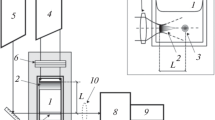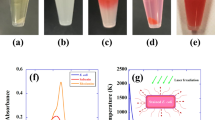Abstract
A study is performed of the inactivation of planktonic bacteria Escherichia coli and Bacillus subtilis by acoustic shock waves generated by a nanosecond laser pulse that causes rapid local heating, growth, and collapse of vapor bubbles in a physiological saline with bacteria containing organic dyes as thermosensitizers. The role of strong electronically excited states of dyes in the local heating of a medium is shown. The dependence of the efficiency of microorganism inactivation on the type and concentration of dyes, the power density of the exciting radiation, and the distance from the source of shock wave generation is studied.







Similar content being viewed by others

REFERENCES
G. S. Simonsen, J. W. Tapsall, B. Allegranzi, et al., Bull. World Health Org. 82, 928 (2004).
C. A. Arias and B. E. Murray, N. Engl. J. Med. 360, 439 (2009). https://doi.org/10.1056/NEJMp0804651
M. Wilson, J. Photochem. Photobiol. 3, 412 (2004). https://doi.org/10.1039/b211266c
M. Donlan, Emerg. Infect. Dis. 8, 881 (2002). https://doi.org/10.3201/eid0809.020063
C. A. Fux, J. W. Costerton, P. S. Stewart, et al., Trends Microbiol. 13, 34 (2005). https://doi.org/10.1016/j.tim.2004.11.010
P. W. Taylor, P. D. Stapleton, and J. Luzio, Drug Discov. Today 7, 1086 (2002). https://doi.org/10.1016/s1359-6446(02)02498-4
M. R. Hamblin, Curr. Opin. Microbiol. 33, 67 (2016). https://doi.org/10.1016/j.mib.2016.06.008
L. Huang, T. Dai, and M. R. Hamblin, Methods Mol. Biol. 635, 155 (2010). https://doi.org/10.1007/978-1-60761-697-9_12
N. Kashef, Y. Huang, and M. R. Hamblin, Nanophotonics 6, 853 (2017). https://doi.org/10.1515/nanoph-2016-0189
M. R. Hamblin and T. Hasan, Photochem. Photobiol. Sci. 3, 436 (2004). https://doi.org/10.1039/b311900a
G. Taraszkiewicz, G. Fila, M. Grinholc, et al., Int. J. Biomed. Res. 5, 150653 (2013). https://doi.org/10.1155/2013/150653
F. Vatansever, W. de Melo, P. Avci, et al., FEMS Microbiol. Rev. 37, 955 (2013). https://doi.org/10.1111/1574-6976.12026
S. N. Letuta, U. G. Letuta, and S. N. Pashkevich, Biophysics 64, 576 (2019). https://doi.org/10.1134/S0006350919040092
A. T. Ishemgulov, S. N. Letuta, S. N. Pashkevich, et al., Opt. Spectrosc. 123, 828 (2017). https://doi.org/10.1134/S0030400X1711008X
S. N. Letuta, S. N. Pashkevich, A. T. Ishemgulov, et al., J. Photochem. Photobiol. B 163, 232 (2016). https://doi.org/10.1016/j.jphotobiol.2016.08.036
V. S. Letokhov, Nonlinear Selective Photoprocesses in Atoms and Molecules (Nauka, Moscow, 1983) [in Russian].
B. Nickel and G. Roden, Ber. Bunsenges. Phys. Chem. 81, 281 (1977). https://doi.org/10.1002/bbpc.19770810308
S. Tobita, Y. Kaisu, H. Kobayashi, et al., J. Chem. Phys. 81, 2962 (1984). https://doi.org/10.1063/1.448046
G. C. Orner and M. R. Topp, Chem. Phys. Lett. 36, 295 (1975). https://doi.org/10.1016/0009-2614(75)80240-5
H. B. Lin and M. R. Topp, Chem. Phys. Lett. 48, 251 (1977). https://doi.org/10.1016/0009-2614(77)80309-6
V. L. Ermolaev and V. A. Lyubimtsev, Opt. Spectrosc. 56, 630 (1984).
C. Nagaoka, M. Fujita, T. Takemura, et al., Chem. Phys. Lett. 123, 489 (1986). https://doi.org/10.1016/0009-2614(86)80048-3
K. K. Rohatgi-Mukherjee and A. K. Mukhopadhyay, Indian J. Pure Appl. Phys. 14, 481 (1976).
V. V. Ryl’kov and E. A. Cheshev, Dokl. Akad. Nauk SSSR 281, 648 (1985).
Laser Applications in Medicine and Biology, Ed. by M. L. Wolbarsht (Plenum, New York, 1977), p. 175. https://doi.org/10.1007/978-1-4615-7326-5
V. V. Ryl’kov and E. A. Cheshev, Opt. Spectrosc. 63, 462 (1987).
S. N. Letuta, Vestn. OGU, No. 5, 88 (2002).
Author information
Authors and Affiliations
Corresponding author
Ethics declarations
This study was supported by the Russian Ministry of Education and Science, FSGU-2020-0003.
Additional information
Translated by G. Levit
Rights and permissions
About this article
Cite this article
Letuta, S.N., Pashkevich, S.N., Ishemgulov, A.T. et al. Inactivation of Planktonic Microorganisms by Acoustic Shock Waves. Russ. J. Phys. Chem. 95, 848–854 (2021). https://doi.org/10.1134/S0036024421040142
Received:
Revised:
Accepted:
Published:
Issue Date:
DOI: https://doi.org/10.1134/S0036024421040142



